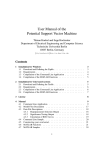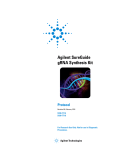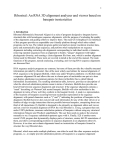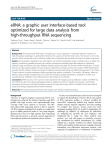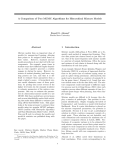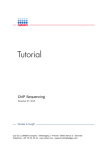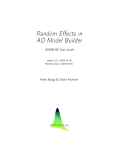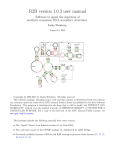Download Manual - CONTRA - Stanford University
Transcript
CONTRAfold 2.02 User Manual (Last modified: August 14, 2008) 1 1 of 20 CONTRAfold 2.02 User Manual Contents 1 Description 2 2 License (BSD) 3 3 Installation 3.1 *nix installation . . . . . . . . . . . . . . . . . . . . . . . . . . . . 4 4 4 Supported file formats 4.1 Input file formats . . . . 4.1.1 Plain text format 4.1.2 FASTA format . . 4.1.3 BPSEQ format . . 4.2 Output formats . . . . . 4.2.1 FASTA format . . 4.2.2 BPSEQ format . . 4.2.3 Posteriors format 5 6 7 . . . . . . . . . . . . . . . . . . . . . . . . . . . . . . . . . . . . . . . . . . . . . . . . . . . . . . . . . . . . . . . . . . . . . . . . . . . . . . . . . . . . . . . . . . . . . . . . . . . . . . . . . . . . . . . . . . . . . . . . . . . . . . . . . . . . . . . . . . . . . . . . . . . . . . . . . . . . . . . . . . . . . . . . . . . . . . . . 5 5 5 6 7 8 8 9 9 Usage 5.1 Prediction mode . . . . . . . 5.1.1 A single input file . . 5.1.2 Multiple input files . 5.1.3 Optional arguments 5.2 Training mode . . . . . . . . . . . . . . . . . . . . . . . . . . . . . . . . . . . . . . . . . . . . . . . . . . . . . . . . . . . . . . . . . . . . . . . . . . . . . . . . . . . . . . . . . . . . . . . . . . . . . . . . . . . . . . . . . 11 11 11 12 13 16 Visualization of folded RNAs 6.1 Installation . . . . . . . . . 6.1.1 *nix installation . . 6.2 Usage . . . . . . . . . . . . 6.3 Additional options . . . . . . . . . . . . . . . . . . . . . . . . . . . . . . . . . . . . . . . . . . . . . . . . . . . . . . . . . . . . . . . . . . . . . . . . . . . . . . . . . . . . . . . . 18 18 18 18 19 Citing CONTRAfold . . . . . . . . . . . . 20 CONTRAfold 2.02 User Manual 1 2 of 20 Description CONTRAfold is a novel algorithm for the prediction of RNA secondary structure based on conditional log-linear models (CLLMs). Unlike previous secondary structure prediction programs, CONTRAfold is the first fully probabilistic algorithm to achieve state-of-the-art accuracy in RNA secondary structure prediction. The CONTRAfold program was developed by Chuong Do at Stanford University in collaboration with Daniel Woods, Serafim Batzoglou. The source code for CONTRAfold is available for download from http://contra.stanford.edu/contrafold/ under the BSD license. The CONTRAfold logo was designed by Marina Sirota. Any comments or suggestions regarding the program should be sent to Chuong Do ([email protected]). CONTRAfold 2.02 User Manual 2 3 of 20 License (BSD) c 2006, Chuong Do Copyright All rights reserved. Redistribution and use in source and binary forms, with or without modification, are permitted provided that the following conditions are met: • Redistributions of source code must retain the above copyright notice, this list of conditions and the following disclaimer. • Redistributions in binary form must reproduce the above copyright notice, this list of conditions and the following disclaimer in the documentation and/or other materials provided with the distribution. • Neither the name of Stanford University nor the names of its contributors may be used to endorse or promote products derived from this software without specific prior written permission. THIS SOFTWARE IS PROVIDED BY THE COPYRIGHT HOLDERS AND CONTRIBUTORS “AS IS” AND ANY EXPRESS OR IMPLIED WARRANTIES, INCLUDING, BUT NOT LIMITED TO, THE IMPLIED WARRANTIES OF MERCHANTABILITY AND FITNESS FOR A PARTICULAR PURPOSE ARE DISCLAIMED. IN NO EVENT SHALL THE COPYRIGHT OWNER OR CONTRIBUTORS BE LIABLE FOR ANY DIRECT, INDIRECT, INCIDENTAL, SPECIAL, EXEMPLARY, OR CONSEQUENTIAL DAMAGES (INCLUDING, BUT NOT LIMITED TO, PROCUREMENT OF SUBSTITUTE GOODS OR SERVICES; LOSS OF USE, DATA, OR PROFITS; OR BUSINESS INTERRUPTION) HOWEVER CAUSED AND ON ANY THEORY OF LIABILITY, WHETHER IN CONTRACT, STRICT LIABILITY, OR TORT (INCLUDING NEGLIGENCE OR OTHERWISE) ARISING IN ANY WAY OUT OF THE USE OF THIS SOFTWARE, EVEN IF ADVISED OF THE POSSIBILITY OF SUCH DAMAGE. CONTRAfold 2.02 User Manual 3 4 of 20 Installation At the moment, CONTRAfold is only available for Unix-based systems (e.g., Linux). We will be porting CONTRAfold to other architectures and making the binaries available. 3.1 *nix installation To compile CONTRAfold from the source code (for a *nix machine): 1. Download the latest version of the CONTRAfold source code from http://contra.stanford.edu/contrafold/download.html 2. Decompress the archive: $ tar zxvf contrafold_v#_##.tar.gz where the #’s are replaced with the appropriate version numbers for the tar.gz you want to install. This will create a subdirectory called contrafold inside of the current directory. 3. Change to the contrafold/src subdirectory and compile the program. $ cd contrafold/src $ make clean $ make Now, your installation is complete! CONTRAfold 2.02 User Manual 4 5 of 20 Supported file formats In this section, we describe the input and output file formats supported by the CONTRAfold program. 4.1 Input file formats CONTRAfold accepts input files which either contain only RNA sequences or contain both sequences and (partial) structural annotations. For the file formats that support specification of (partial) structural annotations (in particular, FASTA and BPSEQ), the provided structures must obey the following properties: 1. Each position in the RNA sequence is marked as either unpaired, paired to some specific nucleotide, or unknown. 2. If position i is marked as pairing with position j, then position j must be marked as pairing with position i. 3. The (partial) structures specified must not have pseudoknots. 4. A position i cannot be marked as pairing unless its specific base-pairing partner has been specified. These structural annotations are generally ignored when performing predictions, unless the --constraints flag is specified on the command-line. These structural annotations are required for training CONTRAfold. The three specific input file formats supported by CONTRAfold are plain text, FASTA and BPSEQ. We describe each of these formats in turn. 4.1.1 Plain text format A plain text format file consists of one or more lines containing RNA sequence data. Each of these lines may contain the letters ‘A’, ‘C’, ‘G’, ‘T’, ‘U’, or ‘N’ in either upper or lower case (the output of the program will retain the case of the input). Any T’s are automatically converted to U’s. Any other letters are automatically converted to N’s. All whitespace (space, tab, newline) is ignored. N’s are treated as masked sequence positions which are ignored during all calculations (i.e., any scoring terms involving an N will be skipped). Other non-whitespace characters are not permitted. Plain text files cannot contain any secondary structural annotation. For example, the following is a valid plain text file: NACGACAGUGUAUCACUAGUAcuuA GUAUGUACUAUC AGUAGUUGUUGUAGUUC CONTRAfold 2.02 User Manual 6 of 20 Note that the blank third line will be ignored, and the initial ‘N’ character will be treated as a placeholder character which appears in the output folded RNA but makes no contribution to the computations. 4.1.2 FASTA format A FASTA format file consists of: 1. A single header line beginning with the character ‘>’ followed by a text description of the RNA sequence. Note that the description must fit on the same line as the ‘>’ character. 2. One or more lines containing RNA sequence data. Each of these lines may contain the letters ‘A’, ‘C’, ‘G’, ‘T’, ‘U’ or ‘N’ in either upper or lower case (the output of the program will retain the case of the input). Any T’s are automatically converted to U’s. Any other letters are automatically converted to N’s. All whitespace (space, tab, newline) is ignored. N’s are treated as masked sequence positions which are ignored during all calculations (i.e., any scoring terms involving an N will be skipped). Other non-whitespace characters are not permitted. 3. (Optional) A structural annotation for the sequence provided above. The structural annotation requires: (a) A single header line beginning with the character ‘>’ followed by a description (any text after the description is ignored) (b) One or more lines of parenthesized structural annotation. These lines provided a structural annotation for each nucleotide in the RNA sequence using a sequence of ‘(’, ‘)’, ‘.’, and ‘?’ characters. A nucleotide annotated with ‘(’ pairs with the nucleotide annotated with the matching ‘)’. A ‘.’ character indicates that the corresponding nucleotide is unpaired. Finally, a ‘?’ indicates a position for which the proper matching (either paired or unpaired) is unknown. Observe that the parentheses in the input file must be well-balanced, i.e., for each left parenthesis, the corresponding pairing position must be marked with a right parenthesis (not a ‘?’), and vice versa. Since CONTRAfold generates only non-pseudoknotted structure predictions, the proper pairing will always be unambiguous. For example, the following is a valid FASTA file: >sequence acggagaGUGUUGAU CUGUGUGUUACUACU caucuguaguucuag uugua Similarly, the following is a valid FASTA file with a structural annotation: CONTRAfold 2.02 User Manual 7 of 20 >sequence acguuggcu >structure (??(..).) But the following is not (starts with the wrong header character): # sequence ATGACGGT Also, the following file is not valid (because the parenthesized structure is not properly balanced): >sequence acguuggcu >structure (..(..).? Finally, the following file is not valid (because the structural information header is missing): >sequence acguuggcu (??(..).) 4.1.3 BPSEQ format A BPSEQ format file is used for describing a single RNA sequence and its annotated secondary structure. This file format contains exactly one line for each nucleotide in an RNA sequence. The ith line of the file contains three items separated by single spaces: 1. The integer i (with i = 1 representing the first nucleotide). 2. The ith character of the RNA sequence (which may be ‘A’, ‘C’, ‘G’, ‘T’, ‘U’, or ‘N’ in either upper or lower case; the output of the program will retain the case of the input; any T’s are automatically converted to U’s; any other letters are automatically converted to N’s). N’s are treated as masked sequence positions which are ignored during all calculations (i.e., any scoring terms involving an N will be skipped) 3. The index of the character to which the ith character base pairs, if known. If the character is known to be unpaired, then 0 appears here. If it is unknown whether this character base-pairs, then a -1 appears here. Note if the BPSEQ file specifies that character i base-pairs with character j, then it must also specify that character j base-pairs with character i. For example, the following is a BPSEQ format file: CONTRAfold 2.02 User Manual 1 2 3 4 5 6 7 A G U C c c u 8 of 20 7 -1 -1 0 -1 -1 1 in which it is known that the first and last positions base pair, and the middle position does not base pair. However, the folding of the other positions is unknown. However, the following is not a valid BPSEQ format file: 2 3 1 4 5 6 7 G U A C C C U -1 -1 7 0 -1 -1 1 since all nucleotides in the file must appear in order. Finally, the following is also not a valid BPSEQ format file: 1 2 3 4 5 6 7 A G U C c c u 7 -1 -1 0 -1 -1 -1 since the first position is specified as pairing with the last position, but not vice versa. 4.2 Output formats The results of a CONTRAfold secondary structure prediction are given in either FASTA, BPSEQ, or posteriors format. We describe each of these in detail. 4.2.1 FASTA format The FASTA output format is identical to the FASTA input format (see Section 4.1.2) with structures. Since CONTRAfold provides predictions for the pairing or non-pairing of every single nucleotides, no ?’s will appear in the output. The output will always consist of exactly four lines, where the first and third lines are FASTA headers for the sequence and structure, respectively, the CONTRAfold 2.02 User Manual 9 of 20 second line specifies the sequence data, and the fourth line specifies the parenthesized structure. If a FASTA file is provided as input, then the header in the FASTA input file will be used as the first line header in the output file; otherwise, the (relative) path to the input file is used as the header. The FASTA header for the structure will always be “structure.” Since CONTRAfold generates only non-pseudoknotted structure predictions, the proper pairing will always be unambiguous. For example, the following parenthesized structure is a completion of the valid BPSEQ file from Section 4.1.3, assuming that the input file is specified in the file data/input. >data/input AGUCccu >structure ((...)) 4.2.2 BPSEQ format The BPSEQ output format is identical to the BPSEQ input format (see Section 4.1.3). Since CONTRAfold provides predictions for the pairing or nonpairing of every single nucleotide, no -1’s will appear in the output. 4.2.3 Posteriors format The posteriors output format is distinct from the BPSEQ and FASTA formats in that it does not provide a single prediction of RNA secondary structure. Instead, it provides a sparse representation of the base pairing posterior probabilities for pairs of letters in the RNA sequence. Specifically, the ith line contains 1. The integer i. 2. The ith character of the file. 3. A space-separated list of base-pairing probabilities of the form j:pij , where j > i is the index of nucleotide to which the ith nucleotide might pair, and pij is the probability that this base pairing occurs. For example, the following is a posteriors format output: 1 2 3 4 5 6 7 8 9 A 7:0.035 9:0.10 G 6:0.036 8:0.11 U C C C U C A CONTRAfold 2.02 User Manual 10 of 20 In the above, we see that nucleotide 2 has an 11% probability of pairing to nucleotide 8. Note that each pairing probability is reported only once (i.e., on the ith line, we show only the pairing probabilities to nucleotides j > i which appear after the ith position in the RNA sequence). CONTRAfold 2.02 User Manual 5 11 of 20 Usage CONTRAfold has two modes of operation: prediction mode and training mode. • In “prediction” mode, CONTRAfold folds new RNA sequences using either the default parameters or a CONTRAfold-format parameter file. • In “training” mode, CONTRAfold learns new parameters from training data consisting of RNA sequences with pre-existing structural annotations. Most users of this software will likely only ever need to use CONTRAfold’s prediction functionality. The optimization procedures used in the training algorithm are fairly computationally expensive; for this purpose, the CONTRAfold program is designed to support automatic training in a parallel computing environment via MPI (Message Passing Interface). 5.1 Prediction mode In prediction mode, CONTRAfold predicts the secondary structure of one or more unfolded input RNA sequence, and prints the result to either the console or output files. The basic syntax for running CONTRAfold in prediction mode is $ ./contrafold predict [OPTIONS] INFILE(s) 5.1.1 A single input file For single sequence prediction, CONTRAfold generates FASTA output (see Section 4.1.2) to the console (i.e., stdout) by default. For example, suppose the file “seq.fasta” contains a FASTA formatted sequence to be folded. Then the command $ ./contrafold predict seq.fasta will fold the sequence and display the results to the console in FASTA format. CONTRAfold can also write parenthesized FASTA, BPSEQ, or posteriors formatted output to an output file. To write FASTA output to a file, $ ./contrafold predict seq.fasta --parens seq.parens To write BPSEQ output to a file, $ ./contrafold predict seq.fasta --bpseq seq.bpseq To write all posterior pairing probabilities greater than 0.001 to a file, $ ./contrafold predict seq.fasta --posteriors \ 0.001 seq.posteriors CONTRAfold 2.02 User Manual 12 of 20 Note that here, the backslash character is used to denote that a command-line is broken over several lines; it is not necessary if you type everything on a single line. Finally, it is also possible to obtain multiple different types of output simultaneously. For example, the command $ ./contrafold predict seq.fasta --parens \ seq.parens --bpseq seq.bpseq --posteriors \ 0.001 seq.posteriors will generate three different output files simultaneously. 5.1.2 Multiple input files For multiple input files, CONTRAfold generates FASTA output (see Section 4.1.2) to the console by default. The output is presented in the order of the input files on the command-line. Using console output is not allowed when MPI is enabled, or when certain other options are selected; in general, we recommend the usage of explicitly specified output files or subdirectories when dealing with multiple input files (see below). CONTRAfold can also write FASTA, BPSEQ, or posteriors formatted output to several output files. In particular, CONTRAfold creates a subdirectory (whose name is specified by the user) in which to store the results, and writes each prediction to a file in that subdirectory of the same name as the original file being processed. For example, suppose that the files “seq1.fasta” and “seq2.fasta” each contain a FASTA formatted sequence to be folded. Then the command $ ./contrafold predict seq1.fasta seq2.fasta \ --parens output will create a subdirectory called output and will place the results in the files output/seq1.fasta and output/seq2.fasta. Alternatively, $ ./contrafold predict seq1.fasta seq2.fasta \ --bpseq output and $ ./contrafold predict seq1.fasta seq2.fasta \ --posteriors 0.001 output generate BPSEQ and posteriors formatted outputs instead. Observe that if multiple input files have the same base name, then overwriting of output may occur. For example, if the input files list contains two different files called seq/input and input, the output subdirectory will contain only a single file called input. Finally, you may also generate multiple types of output simultaneously, as before. Remember, however, to use different output subdirectory names for each. The command CONTRAfold 2.02 User Manual 13 of 20 $ ./contrafold predict seq1.fasta seq2.fasta --parens \ parens_output --bpseq bpseq_output --posteriors \ 0.001 posteriors_output generates three different output subdirectories (parens output, bpseq output, and posteriors output) each containing two files (seq1.fasta, seq2.fasta). 5.1.3 Optional arguments CONTRAfold accepts a number of optional arguments, which alter the default behavior of the program. To use any of these options, simply pass the option to the CONTRAfold program on the command line. For example, $ ./contrafold predict seq.fasta --viterbi \ --noncomplementary The optional arguments include: --gamma γ This option sets the sensitivity/specificity tradeoff parameter for the maximum expected accuracy decoding algorithm. In particular, consider a scoring system in which each nucleotide which is correctly base paired gets a score of γ, and each nucleotide which is correctly not base paired gets a score of 1. Then, CONTRAfold finds the folding of the input sequence with maximum expected accuracy with respect to this scoring system. Intuitively, • If γ > 1, the parsing algorithm emphasizes sensitivity. • If 0 ≤ γ ≤ 1, the parsing algorithm emphasizes specificity. In addition, if the user specifies any value of γ < 0, then CONTRAfold tries trade-off parameters of 2k for k ∈ {−5, −4, . . . , 10}, and generates one output file for each trade-off parameter. Note that this must be used in conjunction with either --parens, --bpseq, or --posteriors in order to allow for writing to output files. For example, the command $ ./contrafold predict seq.fasta --gamma 100000 runs the maximum expected accuracy placing almost all emphasis on sensitivity (predict correct base pairs). The naming convention used by CONTRAfold when γ < 0 follows somewhat different conventions from normal. Running $ ./contrafold predict seq.fasta --gamma -1 \ --bpseq output CONTRAfold 2.02 User Manual 14 of 20 will create the files output/output.gamma=0.031250 output/output.gamma=0.062500 ... output/output.gamma=1024.000000 For multiple input files, $ ./contrafold predict seq1.fasta seq2.fasta \ --gamma -1 --bpseq output will generate output/output.gamma=0.031250/seq1.fasta output/output.gamma=0.031250/seq2.fasta ... output/output.gamma=1024.000000/seq1.fasta output/output.gamma=1024.000000/seq2.fasta. Like before, multiple types of output (parens, BPSEQ, posteriors) may be requested simultaneously. --viterbi This option uses the Viterbi algorithm to compute structures rather than the maximum expected accuracy (posterior decoding) algorithm. The structures generated by the Viterbi option tend to be of slightly lower accuracy than posterior decoding, so this option is not enabled by default. --noncomplementary This option uses a folding model that allows non AU/CG/GU pairings in the CONTRAfold output. This option is slower and generally slightly less accurate than the default option of allowing only “canonical” basepairings. --constraints This option requires the use of BPSEQ format input files. By default, any base pairings that are included in the BPSEQ file above are ignored. However, if the --constraints flag is used, then any base pairings in an input BPSEQ file are treated as constraints on the allowed structures. In particular, 1. A nucleotide mapping to a positive index i is constrained to basepair with nucleotide i. CONTRAfold 2.02 User Manual 15 of 20 2. A nucleotide mapping to 0 is constrained to be unpaired. 3. A nucleotide mapping to -1 is unconstrained. For example, given the following input BPSEQ file: 1 A -1 2 C -1 3 G -1 4 U 7 5 U 0 6 C 0 7 G 4 8 C -1 9 G -1 10 U -1 and the --constraints flag, then CONTRAfold will assume that positions 4 and 7 are constrained to be base-pairing, while positions 5 and 6 are constrained to be unpaired. The base-pairing of the remaining positions is decided by CONTRAfold. The constraints must follow the restrictions described in Section 4.1. --params PARAMSFILE This option uses a trained CONTRAfold parameter file instead of the default program parameters. The format of the parameter file should be the same as the contrafold.params.complementary file in the CONTRAfold source code; each line contains a single parameter name and a parameter value. --version Display the program version number. --verbose Show detailed console output. --partition Compute the log partition function for the input sequence. This option may be used in conjunction with the --constraints option in order to determine the CONTRAfold “energy” of a given RNA secondary structure specified in a BPSEQ file. For example, to compute the energy of a Viterbi parse generated via $ ./contrafold predict seq.fasta --viterbi \ --bpseq seq.bpseq CONTRAfold 2.02 User Manual 16 of 20 we can simply run $ ./contrafold predict seq.bpseq --constraints \ --partition Some quick notes regarding the partition function: • When used in conjunction with partial constraints (i.e., only some of the mappings in the input BPSEQ file are -1’s; see above), then this option computes the log of the summed unnormalized probabilities for all structures consistent with the partial constraints. • In order to compute the log of the summed probabilities (which are normalized as opposed to the quantities mentioned above), you must also run $ ./contrafold predict seq.bpseq --partition and subtract this log partition value from the previous log partition value described above. Note that this quantity will always be greater than or equal to the log-partition above, implying that the log of the summed probabilities is necessarily non-positive (which makes sense as probabilities are at most 1). 5.2 Training mode In training mode, CONTRAfold infers a parameter set using RNA sequences with known (or partially known) secondary structures in BPSEQ format. By default, CONTRAfold uses the L-BFGS algorithm for optimization. For example, suppose input/*.bpseq refers to a collection of 100 files which represent sequences with known structures. Calling $ ./contrafold train input/*.bpseq instructs CONTRAfold to learn parameters for predict all structures in input/*.bpseq without using any regularization. The learned parameters after each iteration of the optimization algorithm are stored in optimize.params.iter1 optimize.params.iter2 ... in the current directory. The final parameters are stored in optimize.params.final and a log file describing the optimization is stored in CONTRAfold 2.02 User Manual 17 of 20 optimize.log In general, running CONTRAfold without regularization is almost always a bad idea because of overfitting. There are currently two ways to use regularization that are supported in the CONTRAfold program: 1. Regularization may be manually specified. The current build of CONTRAfold uses 15 regularization hyperparameters, each of which is used for some subset of the parameters. To specify a single value shared between all of the regularization hyperparameters manually, one can use the --regularize flag. For example, $ ./contrafold train --regularize 1 input/*.bpseq uses a regularization constant of 1 for each hyperparameter. In general, we recommend that you do not perform training yourself unless you know what you are doing; also do not hesitate to ask us. 2. The recommended usage is to use CONTRAfold’s holdout cross-validation procedure to automatically select regularization constants. To reserve a fraction p of the training data as a holdout set, run CONTRAfold with the --holdout p flag. For example, to reserve 1/4th of the training set for holdout cross-validation, use $ ./contrafold train --holdout 0.25 \ input/*.bpseq Note that the --holdout and --regularize flags should not be used simultaneously. CONTRAfold 2.02 User Manual 6 18 of 20 Visualization of folded RNAs Besides the main program, the CONTRAfold package contains some additional tools for visualization of folded RNAs: • make coords: generates a set of coordinates for plotting a CONTRAfold BPSEQ file. • plot rna: converts a set of coordinates and a BPSEQ file into a viewable PNG. In the following subsections, we describe the installation and use of these two tools for RNA visualization. 6.1 Installation Currently, only UNIX installation is supported. 6.1.1 *nix installation To compile CONTRAfold visualization tools from the source code (for a *nix machine): 1. Install the libgd graphics development library, available from http://www.boutell.com/gd/ 2. Install the libpng PNG image library, available from http://www.libpng.org/pub/png/libpng.html 3. Compile the visualization tools: $ make viz 6.2 Usage Given an input FASTA file, generating an image of the predicted CONTRAfold structure involves three steps: 1. Generate a secondary structure prediction in BPSEQ format: $ ./contrafold predict seq.fasta --bpseq \ seq.bpseq 2. Run the make coords program to generate an RNA layout: $ ./make_coords output.bpseq output.coords CONTRAfold 2.02 User Manual 19 of 20 The resulting coordinates are placed in the output.coords file. 3. Run the plot rna program to convert the layout into a PNG image: $ ./plot_rna output.bpseq output.coords \ --png output.png The resulting PNG is placed in the output.png file and can be viewed with a web browser such as Mozilla Firefox. Alternatively, EPS format output is also available: $ ./plot_rna output.bpseq output.coords \ --eps output.eps 6.3 Additional options The plot rna has a couple of options which you can use to control the generated PNG files: --posteriors posteriorsf ile If a CONTRAfold posteriors file is also available,then using the above option will generate a PNG file in which the letters of each RNA nucleotide is colored according to posterior probability confidence. Black letters indicate high confidence structure whereas lighter gray letters indicate lower confidence structure. --title "title" This option allows the user to annotate the generated RNA image with a title. Note that the title string should be surrounded with double quotation marks so as to ensure that it is interpreted as a single argument to the program. In general, the CONTRAfold visualization tools generate RNA layouts which tend to be visually pleasing. The layout algorithm uses a simple deterministic layout rule, followed by a gradient-based optimization procedure. This type of procedure is not guaranteed to generate non-overlapping layouts for all RNA structures; in practice, however the visualization tools can provide reasonable visualizations for a large range of RNA structures. CONTRAfold 2.02 User Manual 7 20 of 20 Citing CONTRAfold If you use CONTRAfold in your work, please cite: Do, C.B., Woods, D.A., and Batzoglou, S. (2006) CONTRAfold: RNA secondary structure prediction without physics-based models. Bioinformatics, 22(14): e90-e98. Other relevant references include: Do, C.B., Foo, C.-S., Ng, A.Y. (2007) Efficient multiple hyperparameter learning for log-linear models. In Advances in Neural Information Processing Systems 20.





















